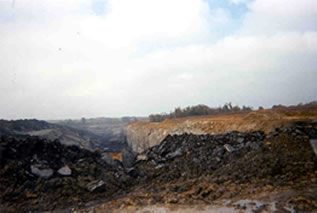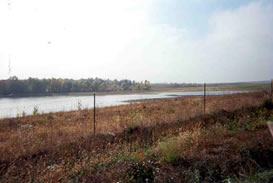|
 Vigo
Coal Company Vigo
Coal Company
Coal is harmful to the environment
in many ways, from mining to burning. The burning of coal
creates air pollution.
Its mining can wreak havoc on the land, particularly surface
or “strip” mining. It destroys
animal habitats, ecosystems and arable lands. Many times,
mining companies will leave stripper pits unfilled, creating
dangerous and barren areas that can contribute to erosion.
Vigo
Coal Company, owned by Koester Companies, is attempting
to reduce some of this damage. They are nationally renowned
for the reclamation
work done on their former mining lands. According to Mr.
John Harman, Vice President of Vigo Coal, the company has
made sincere efforts to reduce the damage that mining can
do and recreate the habitats that are being lost at the Cyprus
Creek Mine Area in Warrick County, southwestern
Indiana.
 |
Overview
of the Cyprus Creek Mine, with coal pile and reclaimed
farm in the distance.
|
Vigo’s efforts begin
with the methods they use to mine. Strip mining
is the most effective way to remove large, flat deposits of
coal. Benching is the process of removing the A and B horizons,
which are different types of soils. A is the highest grade
of tillable soil, and B is lower. The A and B soils are moved
to an area away from the pit and gently stacked. No heavy
equipment is allowed on the piles to avoid compaction, which
can restrict plant root access. The area is then blasted and
the other materials, referred to as spoils, are removed.
The company uses Global Positioning
Systems on its equipment to determine the exact size of the
area that needs to be drilled and blasted. This creates straight
highwalls in rocky areas and straight, GPS measured walls
are safer than approximated ones. Straight highwalls reduce
rock falls and allow heavy equipment to be placed close to
the wall without fear of damage to it or its operator. GPS
is also used in grading the soils and rocks away from the
coal vein. The precise location of the coal layer is in the
computer system, and a bulldozer operator knows where and
how high or low to dig. This precision eliminates waste and
dilution in the coal.
The next step is to remove
the coal, which is also done using GPS. The coal from Cyprus
Creek is sold raw in a minus two-inch size. The wastes from
mining, mostly fly ash, are placed in the spoils pile to avoid
contact with the water table. Vigo constantly tests the ground
water for purity.
After mining is completed,
Vigo works equally hard to re-establish the lands that it
has disturbed.
Ecosystems are created through
hundreds, even thousands of years of natural processes, and
as a result are very delicate. A disturbed habitat can never
be fully restored to its original condition. Nonetheless,
the restoration of habitat is more desirable than leaving
it useless for both humans and wildlife. Vigo makes efforts
to restore the land it mines to its previous condition. The
land is under a five-year bond at approximately $10,000 an
acre, which means that if the land cannot be properly used
after mining, Vigo will pay $10,000 per acre to the landowner.
The types and amounts of soils are carefully measured before
mining begins, and are replaced in those exact proportions
after it is finished. Topography is frequently returned to
its original state as well.
Farmland that is to be mined
is measured for productivity by bushels per acre prior to
any disturbance. After the land is mined and reclaimed, Vigo
must farm the land and return similar production rates for
at least three years. There are times when the land is cultivated
for the full length of the bond in order to be certain of
the productivity rates. Vigo is constantly testing for the
best way to reclaim arable lands, and for which method of
replacing soils gives the best output.
 |
Shallow
area of wetlands at Cyprus Creek. |
In other areas, the land is
restored to its natural state, such as wetlands
or forest. The topography
of the land is measured and recorded using GPS for use in
replacing the soils. The native species of trees are recorded
and used in replanting a forested area. A particular number
of trees per acre must be recorded for the period of the bond
in order for the land to be considered reclaimed. Wetlands
are an expensive venture to run into when mining. They must
be replaced at a higher ratio than other habitats, meaning
that a larger area must be returned to wetlands than was found.
The largest area of wetlands
at Cyprus Creek was reclaimed in the spring of 2002 from a previous
mining operation run by another company. The “Big E”
near Boonville in Warrick County consisted of four abandoned
stripper pits that formed a letter “E” shape. These
pits controlled flooding from nearby Cyprus Creek by channeling
all of the storm water away from the town. Sometime after the
pits were abandoned, a separate company
 |
Deep
area of wetlands with rocks in shallow area.
|
filled in a section of the “E” and the ensuing flooding
became a serious problem in Boonville. Vigo requested permission
from the landowner to turn the area into a wetlands and alleviate
the flooding. They created an 80-foot deep well with shallower
areas surrounding it. Cyprus Creek now has a much larger area
to empty into. The outflow of water is controlled by a culvert,
which also ensures that there will always be water for wildlife.
The hope is that the deeper sections will provide habitat for
fish and the shallower waters will accommodate birds and shallow
water plants. Native species of plant and wildflower have been
planted, and water-loving birds such as sandhill
cranes and mallards are moving in. Vigo’s wetlands
created a win-win situation for the people of Warrick County,
as flooding has been allayed and they now have an area to view
wildlife. Just down
the road from the Cyprus Creek operation is Squaw Creek Mining
Area. At this mine, there are deep lakes
of water left from previous mining activities in the 1950s.
The lakes are filled with slurry, or a mixture of water and
particles of coal that were too small to recover, which are
often called coal fines. Vigo has developed several different
methods of recovering fines such as these from water. The
water pumped back into the lakes is purer than when it was
removed, and allows wildlife to again flourish there.
Vigo always has new and innovative
ideas for making mining more friendly to both the environment
and landowners. They have received three state awards and
two national awards for their reclamation work in different
areas of the country. However, they have not received any
recognition from private environmental organizations. The
area of wetlands near Boonville will most likely be brought
up for a state award in the spring of 2003.
Though coal continues to be environmentally
problematic in many ways, Vigo Coal is making efforts to reduce
the damage they leave behind.
Many thanks are extended to
Ray Smith, owner and proprietor of RJSmith Controls Systems
of Boonville, Indiana, for his information and introduction
of the author to Mr. Harman of Vigo Coal.
|




